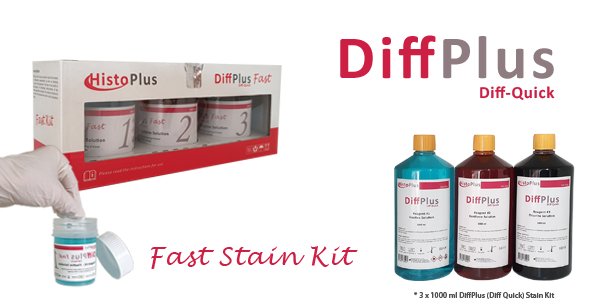Diff-Quik stain is a commercial Romanowsky stain variant, which is used to rapidly stain and differentiate a variety of pathology specimens in the veterinary medicine.
Diff quik stain in The veterinary medicine is prefered as initial screening of cytopathology specimens. This staining technique allows the cytotechnologist or pathologist to quickly assess the adequacy of the specimen.
Composition of Diff quik stain.
The Diff-Quik stain consists of 3 solutions:

- Diff-Quik fixative reagent
-Triarylmethane dye
-Methanol
by dipping the slide for 5-10 times (=nearly 5 seconds) and can increase up to five minutes if the sample is very thick. - Diff-Quik solution I (eosinophilic = red)
this is the first acutual stain.
-Xanthene dye (Eosin Y)
-pH buffer
by dipping the slide for 5-10 times (=nearly 5 seconds) - Diff-Quik solution II (basophilic = blue)
this is considered as a counter stain and can be used alone.
-Methylene blue
-Azure A
-pH buffer
by dipping the slide for 5-10 times (=nearly 5 seconds) . - using distalled water (or tapewater).
Usage of diff-quik stain the veterinary field.
in The veterinary medicine is prefered as initial screening of cytopathology specimens.
This staining technique allows the cytotechnologist or pathologist to quickly assess the adequacy of the specimen as followed :
- Dermatology samples.
- Blood samples.
- bone marrow samples.
- CNS samples.
Diff-Quik stain highlights cytoplasmic elements such as mucins, fat droplets and neurosecretory granules.
The protocol of diff quik stain.
watch this great video to see how the procedure of diff-quik stain works:
Storing Diff Quik stains.
- please Keep a lid on the solutions to prevent evaporation of the fixative agent as methanol and to prevent dust/debris contamination of all the three components.
- prevent direct sunlight which can cause a loss of pigment resulting in pale smears.